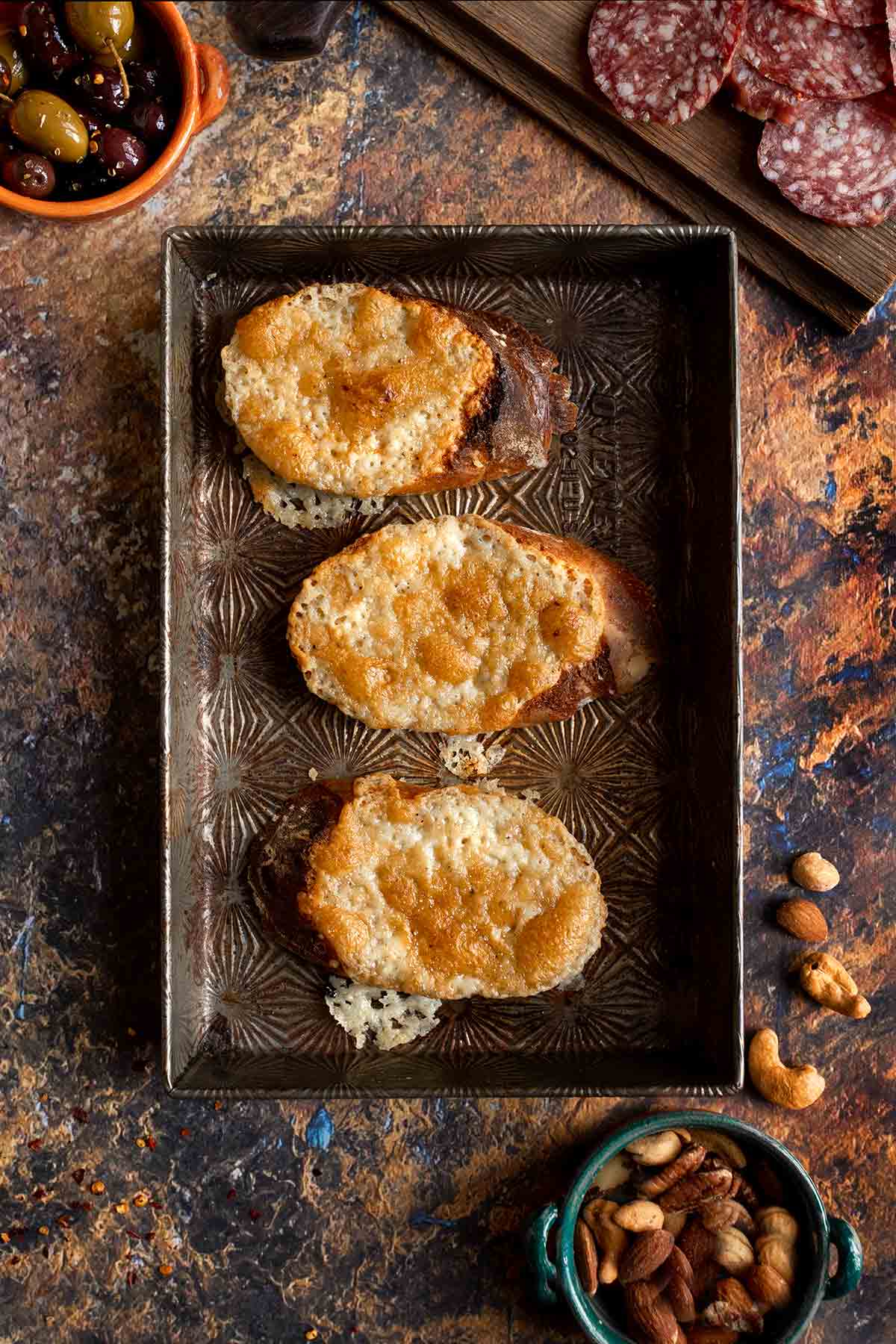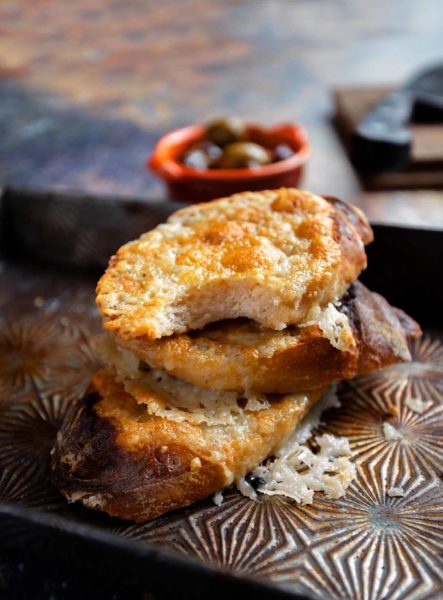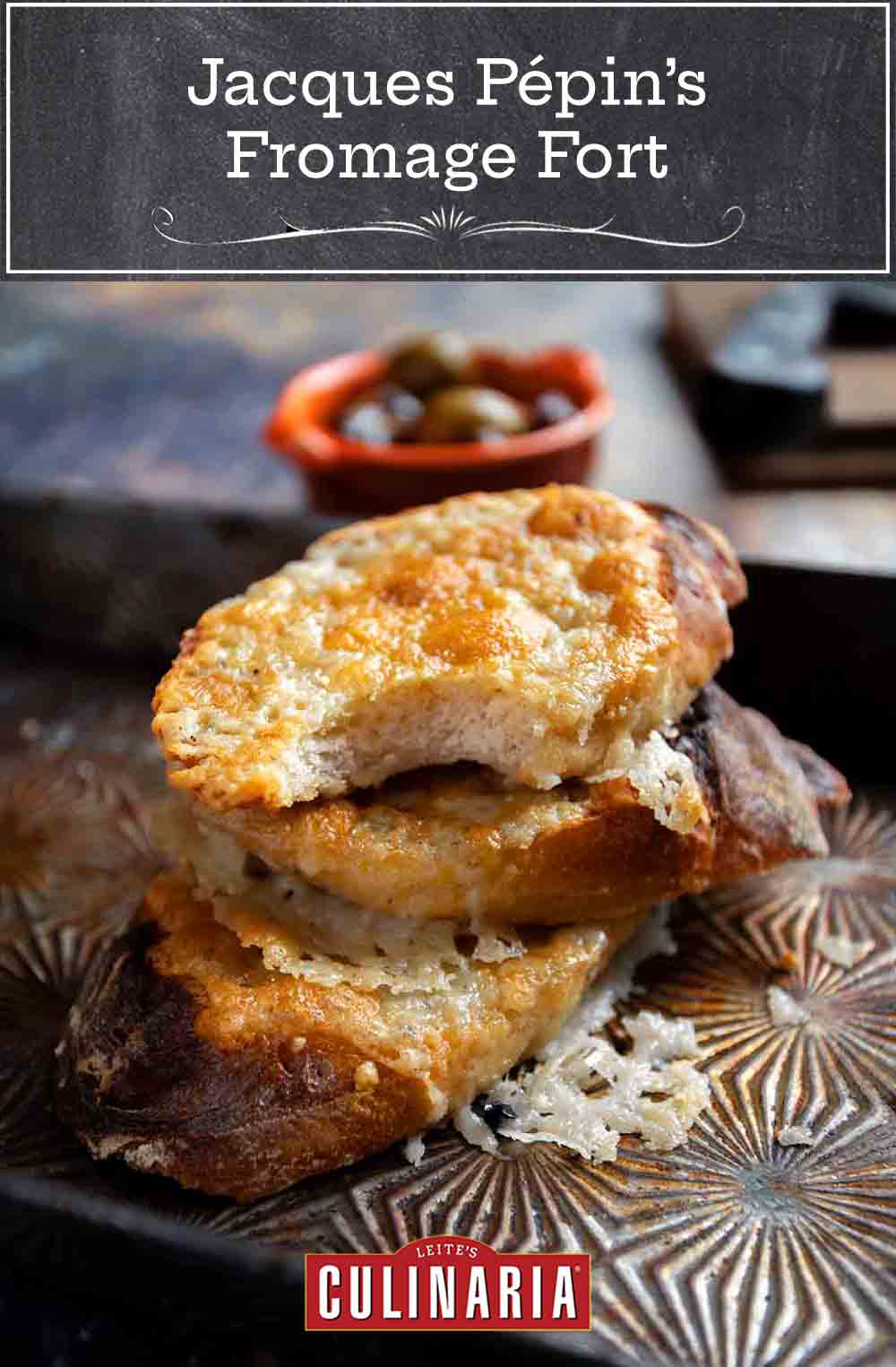
Making fromage fort is the ultimate way of using your leftover cheese. When I think about my father, I can still see the old earthenware crock that he used for marinating his fromage fort, or “strong cheese.” Now, my wife usually makes this at the house. I’m sure that our friends are tired of it, because when Gloria makes it she makes a big batch and freezes it in half-cup ramekins. It freezes well, and defrosted under refrigeration can be served on toast with drinks. Alternatively, we slide the ramekin into the lower part of a very hot oven or under the broiler for five or six minutes for a bubbly, crusty, and fragrant appetizer or salad garnish.–Jacques Pepin
What kind of cheeses are best for making fromage fort?
In Jacques Pepin’s house, he uses whatever is getting down to scraps. The beauty of fromage fort is that the melding of cheeses is aided by the addition of wine and spices. Think of this spread like a sparkling, delicate snowflake—you’ll probably never be able to replicate the same taste profile again. And that’s the beauty of it—experiment with all the possibilities in your cheese drawer. Bear in mind that a good mix of textures (hard and soft cheese) does make for a more interesting finished product.


Fromage Fort
Ingredients
- 8 ounces assorted cheese pieces, such as Brie, Manchego, Fontina, Swiss, blue cheese, or aged Cheddar
- 1 garlic clove, grated
- 1/4 cup dry white wine
- Freshly ground black pepper
- Salt
- Crackers or bread, for serving
Instructions
- In the bowl of a food processor, combine the cheese pieces, garlic, white wine, and a big grinding of black pepper.
- Process until the mixture is creamy but not too soft, 30 to 45 seconds, depending on the firmness of the cheese. Taste, and season with salt, if needed.
- The fromage fort is ready to use now, either served cold, with crackers, or spread on bread and broiled for a few minutes. Broiling will brown the cheese and make it wonderfully fragrant. The fromage fort can also be frozen.
Video

Nutrition
Nutrition information is automatically calculated, so should only be used as an approximation.
Recipe Testers’ Reviews
This fromage fort is to cheese what guacamole is to avocados and banana bread is to bananas. I’ve been making this for years, usually in the aftermath of the annual “Cheesegiving” I have with my sister, and is a great way to use all the odds and ends of various cheeses in your fridge.
True to its name the flavor is very strong, but I wouldn’t have it any other way. I have made it with just about every cheese out there and am a strong believer in balance: if I’m adding something soft like leftover brie, I’ll balance it out with a firmer fontina or Swiss. I also believe it should have some form of blue cheese in it, though it will still be delicious without.
Basically, if you’ve had a cheese platter at a party and have mixed leftovers, this recipe is for you. It’s excellent broiled on crostini (try dunking them in tomato soup or used as the “cheese” component on a grilled sandwich like a panini. I’ve always meant to try making a baked pasta (think the most epic mac and cheese ever), but it always gets eaten before extensive experimentation can commence.
What a simple and clever way to use up some bits of cheese in the fridge. This fromage fort really came together quite quickly, the hardest part was deciding which cheese to use. As I used equal parts blue cheese, gruyere, goat cheese and brie, there was a nice texture, however my blue cheese was quite strong, so the next batch will be only 1 oz of the blue, and I’ll kick up the gruyere a bit more.
It spreads nicely on bread (I used some homemade French bread) right out of the processor, and browns up quickly in the broiler, so keep an eye on it. It paired very nicely with a Rombauer Zinfandel we had opened.
This recipe for fromage fort is a whiz and produces a flavorful, impressive presentation as a snack with wine or as part of a charcuterie presentation. My preference was to brown it in the broiler, and it does come out with a beautiful toasted top when a medium layer is put atop a ½” slice of Italian bread. Just broil until the desired brownness is achieved.
For my test, I used 2oz each of mozzarella/provolone, Gruyere, pepper jack, and grated Parmesan. The peppers in the jack cheese combined nicely with the garlic, pepper and wine. After tasting the mix, I decided not to add any salt, and I think that was a good decision. For the wine, I used a Chardonnay, and I loved the flavor it gave—so of course, Chardonnay would be my choice for a pairing.
The one thing I changed was the process. I don’t like to use a food processor for small amounts of food such as this. I mixed the cheeses together (all were grated) and let them sit to room temperature to soften. I mixed everything with a hand mixer. This gave it just a bit of texture and had no negative impact on the finished toasts. This alternative works well if you don’t need it to be perfectly smooth.
I love cheese in all ways, but sometimes I have a lot of cheese leftovers and don’t know what to do with them. Now, with this recipe for fromage fort, I won’t toss any small piece of cheese in the trash. It’s a very good option for an appetizer and is ready in just a few minutes. For me, it is a keeper.
Who doesn’t love Jaques Pepin, and goodness, how I would have loved to meet his father. This recipe for fromage fort is French retro chic. I love how unpretentious this is with bangs of flavor. I will always know now what to do with the remains of that cheese plate. Using comte, camembert, and gorgonzola, all leftovers, this made up a delicious starter. Served cold, this is good, but broiled on toast, it is tremendous. With the stronger blue veined cheese, proceed sparingly. Perhaps only an 1/8 of your total cheese weight, unless blue is what you are going for. I think another clove of garlic could work for those that are inclined that way as well. Loved that I had everything in my kitchen and could whip up so easily. Served with a mixed salad, this will wow.
I know this cheese concoction as more focused on the leftover’s aspect of the cheese selection and have made fromage fort many times with a wide assortment of older and aging bits and pieces of cheese! As a result, I wish there was not a listing of what father Pépin selected for his cheeses, as there are an unlimited number of options beyond this list. The pepper seems essential, definitely no salt was needed, and more garlic could easily be added for this quantity of cheese. Also note that butter can be added for a creamier more spreadable and rich texture and flavor, and herbs can be added for flavor and to create an even more unique fromage. Spread on bread and accompanied by a bowl of soup yields a lovely snowy end of winter/beginning of spring dinner, and the soup selection can be determined by the cheeses in the mix. In warmer weather, the soup could be subbed out with a salad, and there would be the same lovely light meal.
















What a fantastic way to use up all the cheese nubbins in my fridge! I had some manchego, some extra sharp white cheddar (that I had to trim off the moldy edges!), Some comté, two Mini Baby Bells, and even a couple of tablespoons of Boursin (I felt like the Boursin was a little bit of a cheat but I figured it would help with the creaminess factor). It took me all of about 5 minutes to process everything and it was even more delicious after the flavors sat and married for a few days in the fridge. Talk about the whole being greater than the sum of it’s parts – this recipe is gestalt theory in action!
Sounds fantastic, EEB! Love how you combined all those little bits into something magical. Wow!
I have sometimes whirled some butter in to improve spreadability. I think it can also help marry some of the flavors when you’ve got some strong ones competing with one another. I’ve never thought of wine or pepper or garlic (though I keep a jar of roasted cloves in olive oil in the fridge). I’ll have to give those additions a try.
Thanks for the suggestion!
Do let us know what you think when you try it, Rainey.